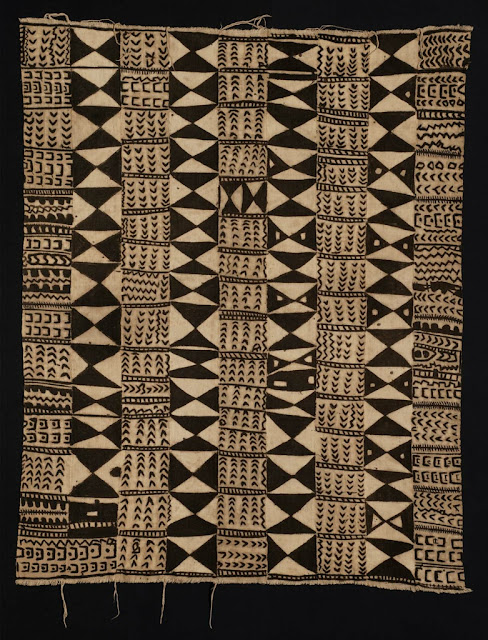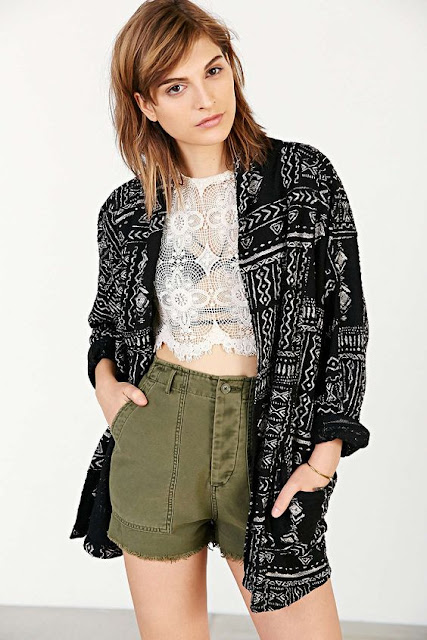Bogolanfini, The British Museum
One of the best-known types of textile from Africa, along with the Kente, is the bogolanfini, the cloth of the Bamana people from Mali in West Africa. This distinctive fabric features variety of wavy lines, circles, chevrons, spots and other geometric figures in white on a black background. But this is not the only thing that makes this textile so unique and interesting. Bogolanfini translates from the Bamana as "mud cloth" and indeed, the main and most important element of the bogolan cloth's production process is mud. But it's not any ordinary mud you can find around the corner. The mud used for bogolanfini making is collected from the very deepest sections of the ponds which become exposed for a few months at the height of the dry season. This mud then is left in a covered pot for about a year, during which time it darkens.
Bogolanfini, 1960. The Museum of Fine Arts , Boston
So, how does the miracle of creation of these striking cloths happen? Strips of cotton woven by men are stitched together to form a cloth which is then handed over to women because this craft remains primarily a women's craft passed on from mother to daughter. The cloth is first soaked in a mulch of leaves from local trees which contain the mordant tannin that dyes it a deep-urine yellow. The pattern is then made on the cloth using fermented mud. Small pieces of bamboo, a blunt knife, spatula of various widths or even a toothbrush are used to draw the design. Many motifs applied to the cloth or combinations of these motifs have names. Some of these names are based on the appearance of the pattern, such as "fish bones", "little stars", or "square". A few refer to historical events, others to aspects of women's daily experience. The remainder of the cloth is then carefully covered with the mud around the outlined motifs.
Bogolanfini, The British Museum
When introduced to sunlight the iron oxide in the mud reacts with the tannic acid in the cloth to produce a colorfast black ground for the design. Once the mud has dried it is washed off with water and the remaining yellow areas are bleached white with a mixture of millet, peanuts and caustic soda. The mixture is carefully painted over the yellow design and left to dry for a week. When it is washed off the yellow has turned white and the cloth is finally complete. The whole process may be repeated several times to deepen the shade of black. That's the traditional way. For the tourist market, however, bogolan makers often use stencils and chemicals nowadays instead of the mud and hand-painting to speed up the process.
Bogolanfini, The British Museum
Originally bogolanfini were worn to mark important life stages like initiation, marriage, childbirth and death. Warriors and hunters wore bogolanfini, too. The specific meandering patterns were supposed to disorient any threatening spirits and not to let them penetrate the wearer's body. Bogolanfini with simplified patterns were worn later as everyday dress well into the 20th century.
Modern bogolanfini jacket from Urban Outfitters
Throughout the 20th century bogolanfini textiles became less popular. A revival of the cloth started in the 1980s after Malian designer Chris Seydou attracted much interest with a wrap of bogolan in his 1979 fashion show. He rapidly increased the use of the fabric through the 1980 and early 1990s. Nowadays hand-painted bogolanfini testiles and factory cloth printed with bogolanfini designs are fashioned into jackets, vests, blouses, classic men's and woman's tunics, hats and bags. You can find towels, sheets, and bathrobes depicting bogolanfini patterns, too. Many designers are still get inspired by the mud cloths to create their own "white on a black background" patterns.
References:
Encyclopedia of World Dress and Fashion. Vol.1 Africa
The Art of African Textiles by Duncan Clarke
African textiles by John Gillow







Thank you so much for your full knowledge that we hope you will bring forth such new facts in front of us. Thank you very much once time again. mental disorder
ReplyDelete